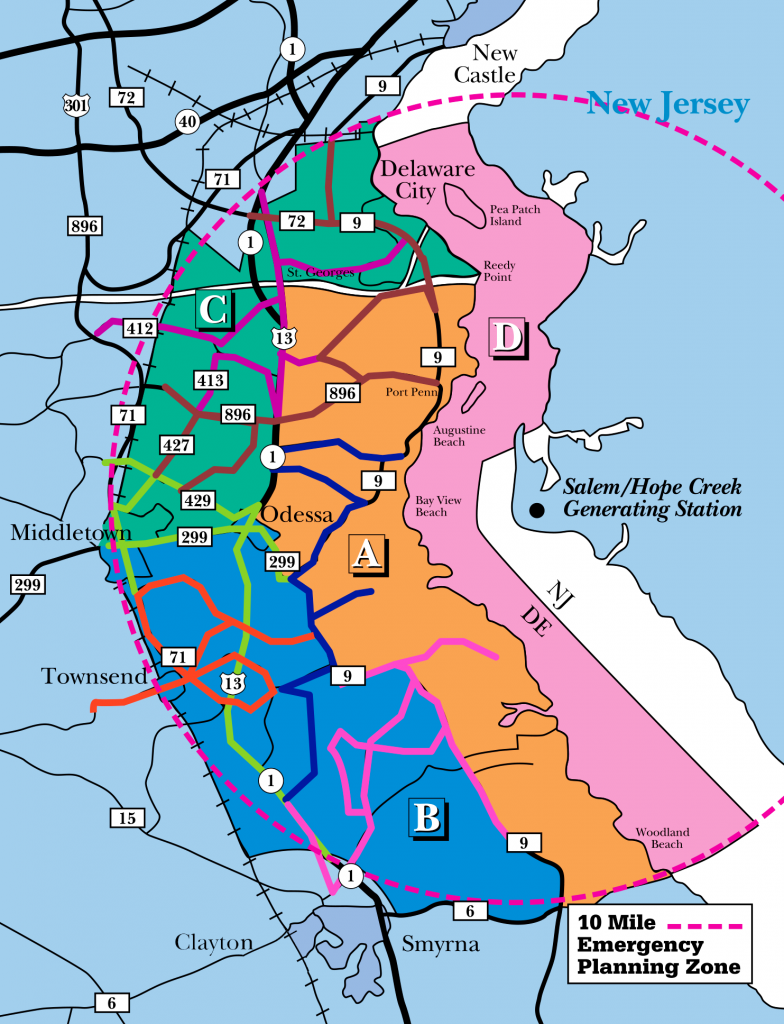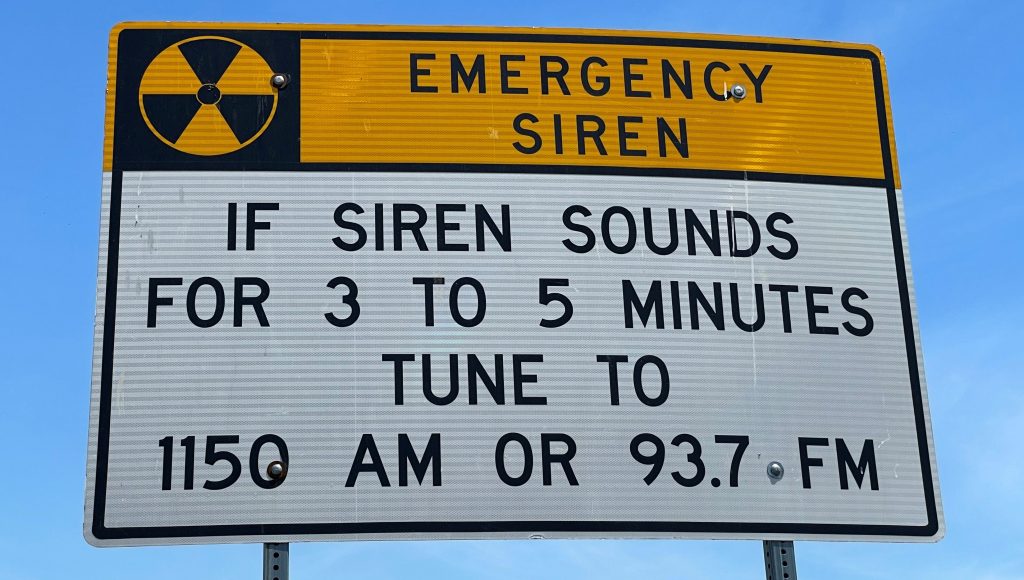Find your evacuation zone at PrepareDE.org
SMYRNA, Del. – Governor John C. Carney, Jr. and the Delaware Emergency Management Agency are observing “Hurricane Awareness Week” from May 29 to June 2 by encouraging residents and visitors to “know your zone” and “get prepared” for the start of the Atlantic hurricane season, which begins on June 1.
Hurricanes are the most intense type of tropical cyclone, a rotating weather system that forms over tropical or subtropical waters. In the Northern Hemisphere, cyclones rotate counterclockwise and are classified by their maximum winds: tropical depressions have winds up to 38 mph, tropical storms from 39 to 73 mph, and hurricanes 74 mph or higher. A major hurricane has winds of at least 111 mph, corresponding to a Category 3, 4 or 5 on the Saffir-Simpson Wind Scale.
Hurricane hazards include extreme winds, coastal and inland flooding, tornadoes, high surf, and rip currents. Though classified by wind speed, more than 90% of hurricane fatalities are due to flooding and storm surge. But flooding isn’t always confined to the coast: it can occur hundreds of miles inland due to excessive rainfall.
Delaware is uniquely vulnerable to coastal storms because it is located on the Delmarva Peninsula and has the lowest average elevation of any state—about 60 feet above sea level.
Recent history shows even the remnants of a system can pack a powerful punch. In August 2020, Tropical Storm Isaias spawned at least three tornadoes in Delaware according to the National Weather Service. One was a record EF2 tornado that traveled from Dover in Kent County to southwest of Glasgow in New Castle County. In Milford, one woman was killed by a falling tree after the storm. In September 2021, remnants of Hurricane Ida resulted in heavy rainfall that caused the Brandywine Creek to flood areas of downtown Wilmington. Over 200 people were rescued from flooding and millions of dollars in catastrophic property damage resulted in a federal disaster declaration for New Castle County.
The National Oceanic and Atmospheric Administration (NOAA) is now forecasting a “near-normal 2023 Atlantic hurricane season.” That could amount to 12 to 17 named storms, 5 to 9 hurricanes (winds of 74 mph or higher), and 1 to 4 major hurricanes (111 mph or higher). NOAA predicts a high potential for the El Nino pattern to develop, which can suppress hurricane activity. However, this could be offset by favorable conditions such as warmer-than-normal sea surface temperatures in the Atlantic.
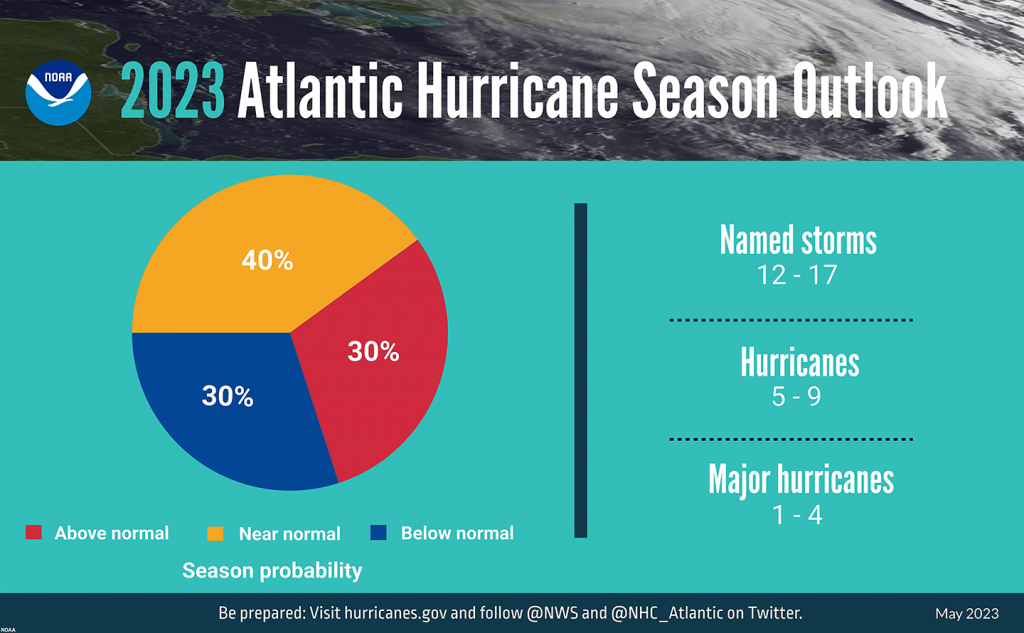
Regardless of the seasonal forecast, it only takes one storm to have a severe, life-changing impact. With the increasing frequency and intensity of extreme weather, it is crucial for families and businesses to be well-informed and well-prepared. Hurricane Awareness Week is a timely reminder for everyone to take necessary precautions and plan ahead.
PrepareDE.org, Ready.gov, National Weather Service, National Hurricane Center, and HurricaneStrong.org offer a wealth of information and resources on how to prepare and take action. PrepareDE.org is also available in several languages. Users can click the “select language” tab at the top right of the home page.
New for 2023 Season: “Know Your Zone”
Evacuation Zones in Delaware are identified as either A, B, C or D. These zones encompass low-lying areas susceptible to flooding and storm surge. When emergencies or disasters happen, officials issue evacuation warnings or mandatory orders for communities in impacted or potentially impacted Evacuation Zones.
It’s important to know the Evacuation Zone before a disaster strikes because it includes specific routes and proper guidance in the event of an emergency. Evacuating in a planned method by zone reduces unnecessary travel, roadway congestion and overcrowding, and allows for quicker, safer movement during emergencies and disasters. Knowing the zone in advance is a time-saving opportunity for families.
The new “Know Your Zone” webpage at PrepareDE.org can help users identify if their location is in one of the state’s four evacuation zones. Users can locate their zone in two ways: the Evacuation Zone Lookup Tool or the Interactive Evacuation Zone Map.
For the lookup tool, simply enter an address in the field and click “search.” For the interactive evacuation zone map, the PC or mobile phone must have location access enabled for the feature to work properly. By clicking the “find my zone” button, the page will automatically calculate your location from your internet data and location. If your PC’s IP address is routed through another location or server, or if your mobile phone does not have location enabled, it is best to use the lookup tool instead. Otherwise, the result will not represent the actual location.
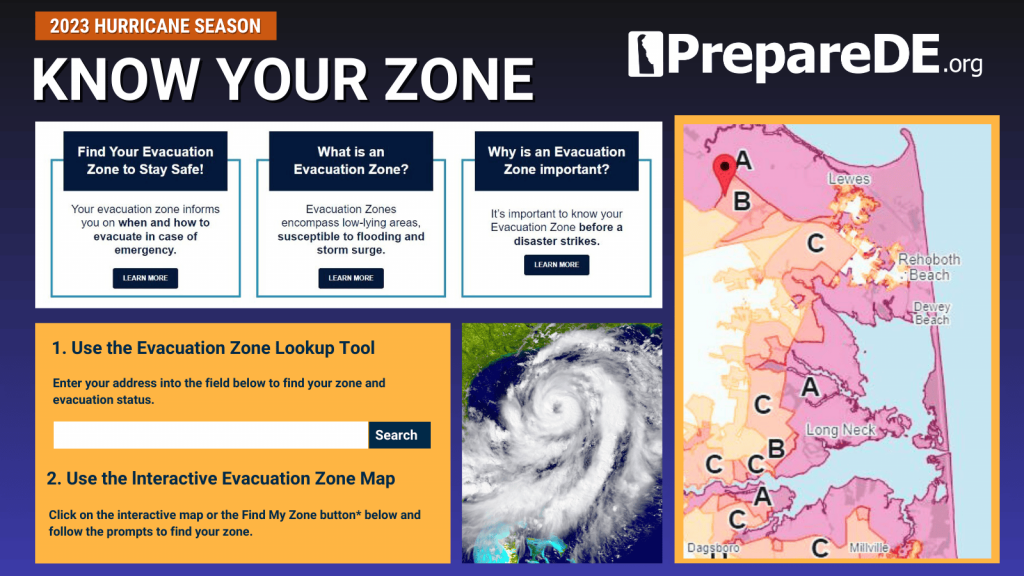
Now that I know my Evacuation Zone, what do I do?
During an emergency event, Delaware state officials will use the letter associated with the affected Evacuation Zone(s) when issuing an evacuation warning or order. Keep your specific Evacuation Zone information (A, B, C or D) in an easy to reach place, such as on your refrigerator or with other emergency information (like your emergency kit).
Look over the map of Delaware Evacuation Routes
- Know your hurricane and flood risk and take steps to prepare. Are you in an evacuation zone? Find out at preparede.org/know-your-zone. Are you in a flood zone? Use the flood planning tool at de.gov/floodrisk.
- Just because you don’t live near the coast doesn’t mean you’re not at risk. Remnants of tropical systems can bring tornadoes, extreme rainfall, and life-threatening flooding to areas hundreds of miles inland from the coast.
- Plan now – know what you’ll do if a hurricane is forecast to impact your area, how to contact your family, and any community emergency plans. Learn how to make a plan at
- Declutter drains and gutters to allow water to flow.
- Check out the trees on your property and consider trimming trees and dead limbs.
- Protect the life you’ve built by purchasing or renewing a flood insurance policy. It can take up to 30 days for a policy to go into effect. Most homeowner’s policies do not cover flooding. Learn more at floodsmart.gov
- Take into account seniors and those with special needs. Learn about the DHSS Office of Preparedness and its “Preparedness Buddy” program. The University of Delaware also has resources to help plan for an emergency at: www.allreadyde.org
- Pets and Animals: The DHSS Office of Animal Welfare and Delaware Animal Response Program has resources for animals and emergencies.
- “Practice makes prepared!” Once you have a plan, go over it and make sure everyone knows what to do. Include children in your plan and help them practice it with the family. Check out the brochure “Prepare with Pedro” at ready.gov.
- Gather supplies for at least one week for every member of the family, including non-perishable food, water, medications, and even infant formula and diapers for small children.
- Include a first aid kit, flashlights, radios, matches in a waterproof container, and spare batteries.
- Keep a small amount of cash in a safe place in case ATMs are not working.
- Don’t forget pet supplies, including crates, extra food and water, and other items they may need.
- Keep important documents in a safe place or create password-protected digital copies. Consider using a waterproof container to store the copies.
- Have a cell phone power bank or portable car charger and try to charge phones ahead of time.
- Make sure your car’s gasoline tanks are filled and replenish propane tanks for outdoor grills.
• Consider getting a generator or other power backup source. Remember, ONLY USE a generator or other gasoline-powered machinery OUTDOORS and away from windows.
- Check on your neighbors to make sure they are safe and prepared and have supplies they need.
- Review insurance policies to make sure you are covered. Document your property in advance, including photographs, in case you need to make an insurance claim.
- Hurricane season is also a good time to sign up for emergency alerts through the Delaware Emergency Notification System (DENS). DENS is the primary system for public warning and protective action information, allowing emergency managers to send messages down to the specific street, neighborhood, or larger areas (like Evacuation Zones) affected by the event. If there is an evacuation notice, it will be sent by text, call, email, or social media, depending on user preferences.
- Download the FEMA app. You can receive weather alerts from the National Weather Service for several different locations anywhere in the United States.
- Tune to local television or radio stations to learn which areas are affected by a potential storm and if/when an evacuation warning or order has been issued for your specific zone.
- Social Media: Follow DEMA and local government sources online for the latest news and information from the State of Delaware. DEMA publishes information via social media on Facebook, Instagram, Twitter, and Next Door.
The list of named storms for 2023 is very similar to the one from 2017 because the World Meteorological Organization reuses the names every six years, unless a storm is so powerful or damaging that its name is retired. The names Harvey, Irma, Maria, and Nate were retired from the 2017 season. Tropical Cyclone Names for 2023: Arlene, Bret, Cindy, Don, Emily, Franklin, Gert, Harold, Idalia, Jose, Katia, Lee, Margot, Nigel, Ophelia, Philippe, Rina, Sean, Tammy, Vince, and Whitney.
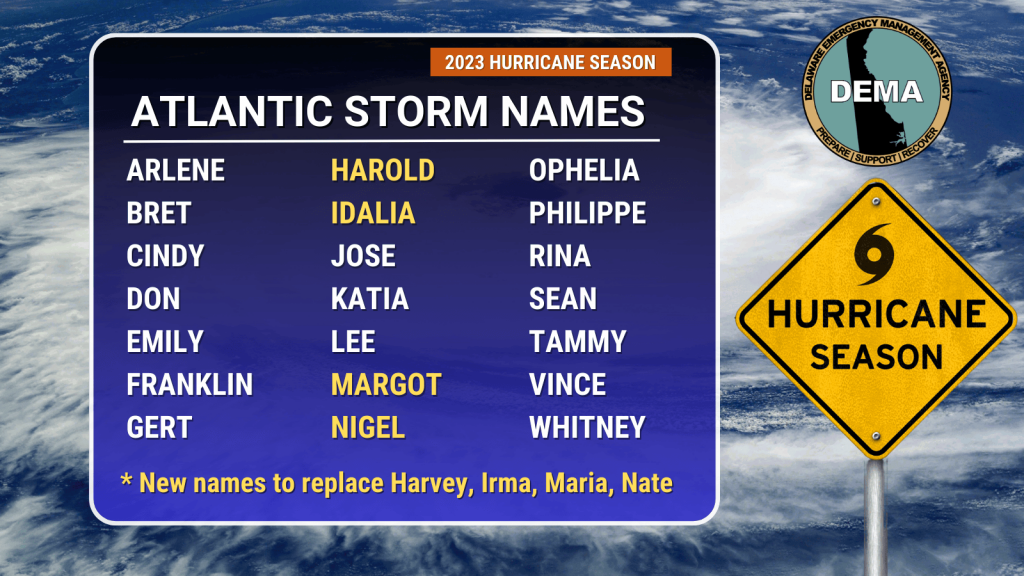
Delaware encourages residents to take advantage of Hurricane Awareness Week by reviewing their emergency plans, updating disaster supply kits, and staying informed about weather forecasts and evacuation notices. By being prepared and informed, we can minimize risks and protect ourselves, our loved ones, and our communities.
Experts agree the best time to prepare is now, before a storm, and there are many county, state, and federal resources to help residents get ready.
Resources and Links:
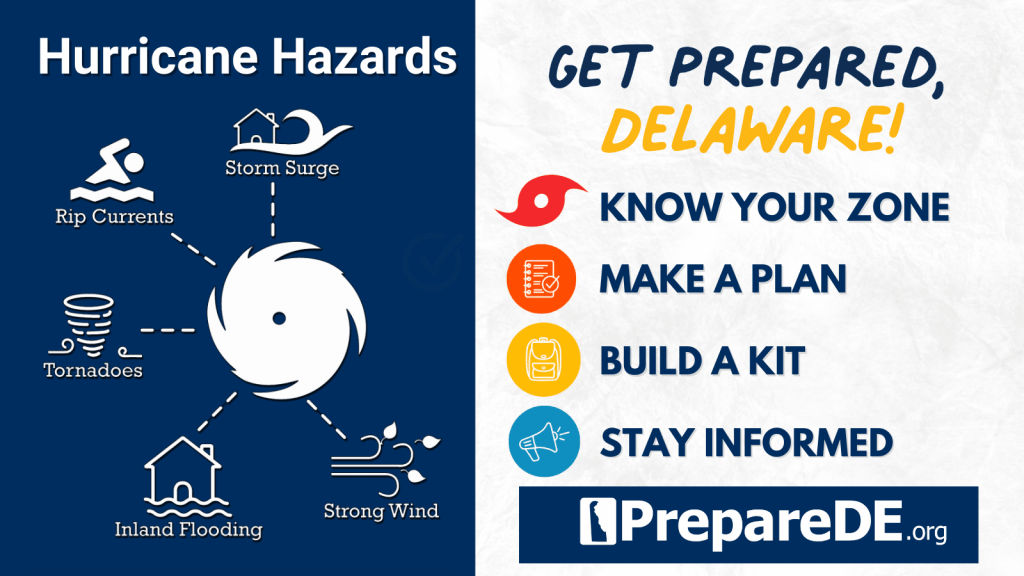
ABOUT DEMA
The Delaware Emergency Management Agency (DEMA) is the lead state agency for coordination of comprehensive emergency preparedness, training, response, recovery, and mitigation services to save lives, protect Delaware’s economic base and reduce the impact of emergencies. DEMA is a division within the Department of Safety and Homeland Security (DSHS) and authorized by Delaware Code, Title 20,Chapter 31 §3101-3130.
Social Media: Delaware Emergency Management Agency on Facebook and Twitter and Instagram

